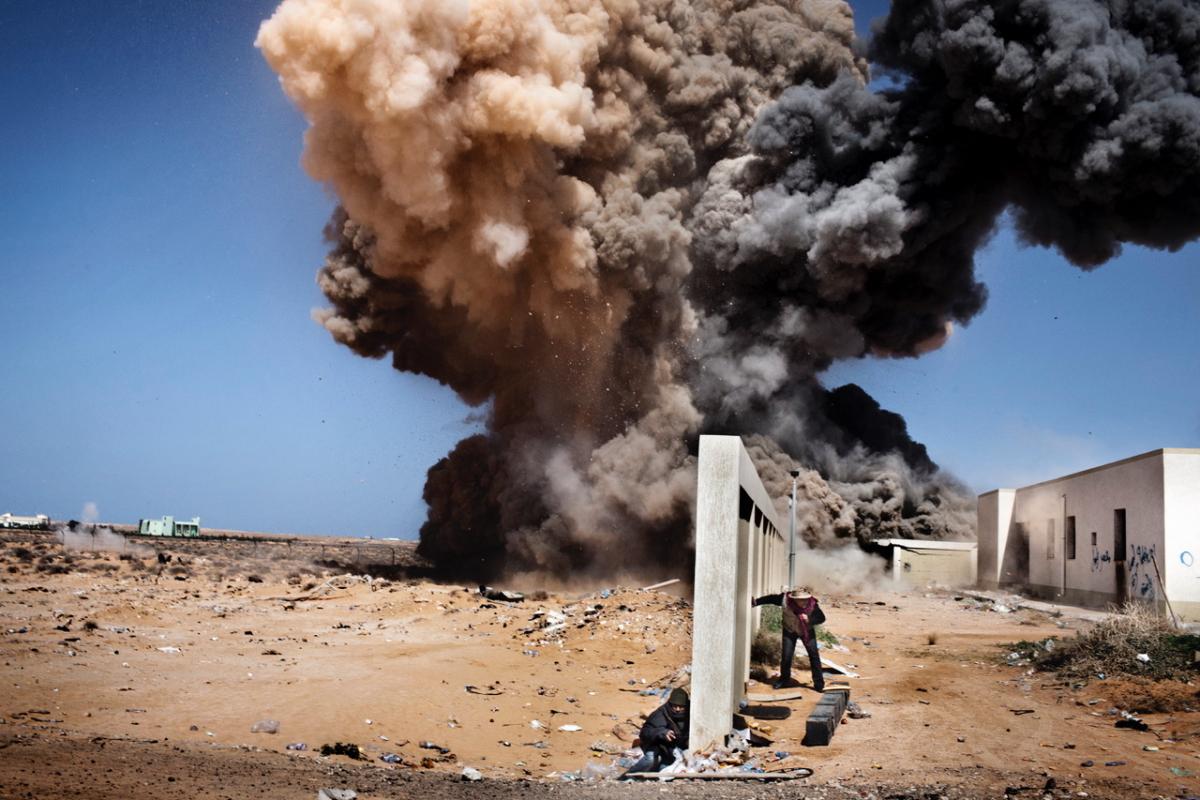What are the political implications and ethical concerns of sampling sounds of war? This is a critical question raised by The End of Silence, a 2013 record from the British composer Matthew Herbert based entirely on a six-second field recording of the Libyan civil war. Musicologist Luis Velasco-Pufleau examines this question and argues that sound and music can enable critical examinations of the rationale of war.
We are used to seeing violence and explosions, but listening to it is still new. (Matthew Herbert)
In June 2012, Matthew Herbert performed and recorded live with three other musicians The End of Silence, a three-track album based entirely on a field recording made by war photographer Sebastian Meyer during the Libyan civil war (Herbert 2013a). Part of Herbert’s motivation to make this record was an ethical and political concern: to remind himself of «the privilege of peace» that he is «currently afforded, living a lifestyle subsidized by others who happened to be born above oil» (Herbert 2013b).
Is it ethically acceptable to compose music from sounds of war? There is no simple answer to this question since, in my opinion, ethics is relative to particular situations and therefore it is not possible to develop a general and normative point of view about it. However, there are at least two points that are essential for developing any reflections on the issue. Firstly, where does the sound come from, who recorded it, and in which conditions? Secondly, how is this sound performed and transformed into a new record? The End of Silence offers an opportunity to reflect on the ethical boundaries and political implications of sampling sound.
Capturing the Moment of War
Because Herbert believes «music is not about organizing sound only», he considers reflecting on the source of sound to be essential: «where a sound is from, how I got it, who recorded it with what microphone, is part of the story» (Herbert quoted after Burkhalter 2016). Sebastian Meyer’s Libya field recording comes from a time when Meyer was continuously recording sound while shooting photographs on the frontline. He decided to do this because he thought that photographs were incapable of depicting much of what he experienced at these moments. For Meyer, «a photograph is inherently still and silent», while «combat is inherently moving and loud» (Velasco-Pufleau and Meyer 2018). He wanted to capture sound in order to better understand his own experience of war. In 2011, Meyer was on a Libyan frontline with a group of combatants when a Gaddafi war plane dropped a bomb. The bomb exploded just around one hundred meters behind him. After a few seconds of sensory saturation, he turned around and shot photographs. Herbert finally requested the file after listening to it on Sebastian Meyer’s website.
Performing a Cohabitation of War and Nature
Both Meyer’s and Herbert’s records are challenging. Meyer’s field recording is a sonic remnant of a violent event where people lost their lives, a sound document of anonymous fighters in a war-torn country. On the other hand, Herbert views The End of Silence as a «generalized memorial» of war, and he wants «that moment to be remembered so that this explosion and these victims do not become yet another incident in some distant part of the world». Herbert asks people «to listen more carefully and not to just let traumatic moments pass by without stopping and reflecting on them» (Herbert after Burkhalter 2016).
However, a recording is always selective; it mediates sensory experiences lived by oneself or others. It is neither a memorial by itself, nor «the translation of a whole world of sound» (Michel Chion in Velasco-Pufleau 2017, 169). Herbert and the rest of his musicians were aware of that. They developed strategies to challenge the original context of the field recording, reinserting it in a new temporality and space. Deciding to record The End of Silence live, they produced multiple fields, affording to the auditory a new way of listening to it. The musicians set up witness microphones during the live performance and later mixed both sound spaces in order to create a third. We hear sounds from their outside environment (birdsongs and a dog barking) and samples of combatants whistling and shouting, the bomb falling and exploding. They perform a cohabitation of wartime violence and peacetime nature.
Enabling Critical Thinking Through Sound
The End of Silence potentially brings Meyer’s sound to a larger audience in a way that they can relate to, interact with, and feel. Meyer acknowledges the limits of sounds and photographs to help other people imagine the horrors of war. If we haven’t endured war, it is difficult to situate testimonies and sonic remnants of war in a meaningful context. However, listening involves knowledge production: even if other people cannot imagine how terrifying war is, documents produced at wartime can enable critical thinking and further examinations of the rationale of war.
Here, philosopher Susan Sontag’s reflections on war photography are useful to think about the political possibilities of sound recordings of war: «Neither is the photograph supposed to repair our ignorance about the history and causes of the suffering it picks out and frames. Such images cannot be more than an invitation to pay attention, to reflect, to learn, to examine the rationalizations for mass suffering offered by established powers» (Sontag 2003, 104). Similarly, we cannot expect that music and sound repair our ignorance about the wars to which they refer. No intrinsic properties of sound can reveal by themselves the situation of recording, which is always relational. Music and sound are symbolic resources that people can use in order to give meaning to their reality; they can foster critical and collective consciousness. It is our responsibility to pay attention to their stories, to ask questions, and to reflect on the privilege of listening to them in peacetime. The End of Silence is an opportunity to do that: to listen carefully in order to deepen our knowledge of the experience of war.
